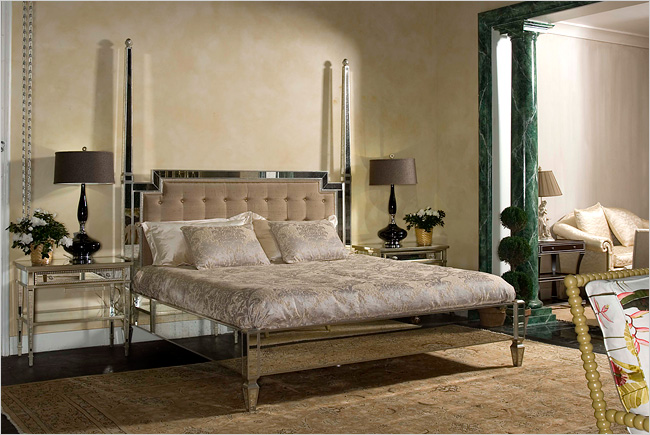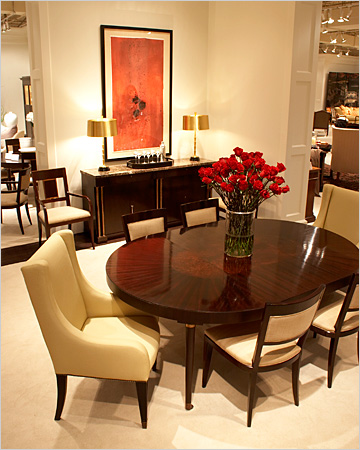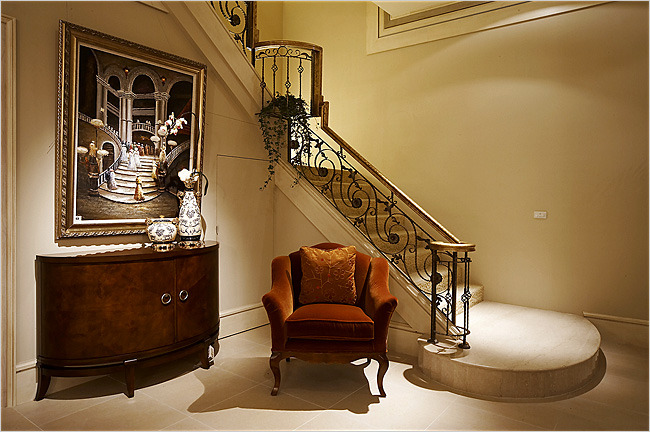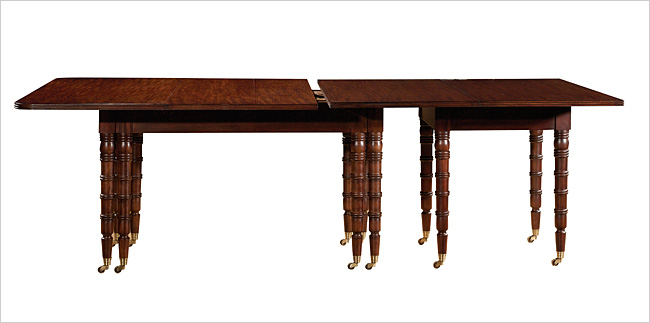Although most manufacturers faced gloomy sales forecasts at last week’s High Point Market — the largest furniture industry trade show in the world, with 85,000 attendees and 12 million square feet of show space — purveyors of high-end furniture were concentrating on one of the industry’s few bright spots, the growing overseas market for American-made luxury furnishings.
According to people both within and outside the industry, rich consumers in countries new to high-end consumer culture now see furniture from the United States as desirable as porcelain from Limoges and Italian sports cars.
The American industry’s relatively new embrace of of-the-moment styling, combined with brand-name designers and a longstanding tradition of fine craftsmanship, has helped cultivate an image that speaks to foreign consumers’ desire for the best of everything. And they are spending accordingly, on dining chairs backed with rare ebony, hand-upholstered settees and dining sets that comfortably seat 20.
“These people have shopped the world, and what they want are products that are well designed and crafted beyond ordinary standards,” said Steve Nobel, chairman of the Luxury Home Alliance, a group that promotes American and international luxury goods and services for the home.
But that’s not all they want, said Jerry Epperson, who analyzes the American furniture market for Mann, Armistead & Epperson in Richmond, Va. They also want products that showcase their new status, which America’s large-scale upholstered and wood furniture is uniquely suited to do.
“I’ve been to Japan, China, India, all these places, and one of the things they brag about is that they have American furniture,” Mr. Epperson said, “the implication being that they have a home big enough that they can even use American furniture.”
Radha Chadha, a branding consultant in Hong Kong and co-author of “The Cult of the Luxury Brand: Inside Asia’s Love Affair With Luxury,” said that American furniture is instantly recognizable to many Asians, and therefore an effective status symbol. “Whereas other luxury brand products, like Louis Vuitton bags, are used by Asian consumers from all walks of life,” she added, “only people at the very top end can afford luxury American furniture.”
There is no small irony in these developments for the struggling American furniture industry. Despite hard-fought efforts to keep manufacturing jobs in North Carolina, where the industry has been based for more than 100 years, over the last decade most companies moved the bulk of their wood furniture manufacturing overseas, succumbing to the same pressures of globalization as other American industries.
Now, most “American” furniture sold by venerable companies like Thomasville, Broyhill and Hooker Furniture actually comes from places like China, Vietnam and the Philippines.
And even as this shift has helped keep prices competitive in the lower and middle ranges of the market — and in many cases even driven them to record lows — American spending on furniture has declined more sharply this year than at any time since 1982, Mr. Epperson said.
The top range has not been spared: 11 days before the High Point Market began on Oct. 1, Henredon, an American company that was founded in Morganton, N.C., in 1945 and that produces lines by Ralph Lauren and Barbara Barry as well as its own upscale collection, announced plans to close a large factory there, eliminating more than 500 jobs.
“It’s a very difficult thing to have to do because we have personal friendships and relationships there,” said Tom Tilley, the president of Henredon. “It’s heart-wrenching.”
Henredon plans to open a new, smaller factory in North Carolina for custom work and expects to hire more than 100 people, but the mass assembly of wood furniture will be transferred to the Philippines.
Meanwhile, though, Henredon’s sales abroad have been increasing steadily, said David Parker, its vice president for international sales. Although Henredon’s parent company, Furniture Brands International, will not release revenue figures for its divisions (its second-quarter sales in 2007 fell 10.99 percent from last year), Mr. Tilley said that overseas sales now account for 10 percent of Henredon’s income, double what it was in 2004.

![]()
OUTWARD BOUND American companies selling furniture abroad include E. J. Victor.
At Century Furniture, which still makes 90 percent of its products in Hickory, N.C., international sales now make up about 10 percent of the company’s estimated $180 million revenue, more than twice what it was five years ago, said Edward M. Tashjian, Century’s vice president for marketing.
It has found two of its biggest and fastest growing markets in Dubai and Japan (where customers are particularly fond of pieces from well-known designers like Oscar de la Renta and Kelly Hoppen, Mr. Tashjian said), and it is developing a following in China, which is the United States’ largest provider of furniture imports and the source of $5 billion worth of furnishings sold by American retailers last year.
In May, Eddy Hsiao, a Chinese entrepreneur who made his fortune manufacturing some of this low-cost furniture, opened the first Century showroom in Taiwan, in downtown Taichung, and in September he opened the first one in mainland China, in Shanghai.
Betting that the market for Century pieces will keep growing, he plans to open a showroom in Shenzhen this month and a fourth location, in Beijing, by the end of the year.
Based on sales at the Taichung location over the last few months, Robert Maricich, Century’s president and chief executive, estimated that its sales in China would reach $7 million to $10 million this year.
To be sure, a big reason for the boom in foreign sales is the languishing dollar, which has made expensive American furnishings affordable for many with bank accounts measured in euros or rupees.
Even countries famous for their furniture, like Norway and Italy, are snapping up American pieces: exports of wood furniture from North Carolina to Norway between January and July were up about 500 percent over the same period last year, according to the North Carolina Department of Commerce’s International Trade Division; the state’s exports to Italy were up nearly 700 percent.
 Henredon. |
But the largest shift was among upholstered pieces sent to China, which increased by more than 4,000 percent between the first half of 2006 — when they accounted for less than a half of a percent of the state’s upholstered exports — and the same period in 2007. Mr. Tashjian, who oversees Century’s marketing worldwide, said that surge was about more than low prices. Chinese furniture is “boxy, unrefined and common” to the eyes of the newly affluent Chinese, he said. “It’s almost vulgar. Part of them displaying their wealth is having something everyone else doesn’t have.”
Mr. Maricich, who has been working for more than a decade to break Century into the Chinese market, was more circumspect. “In China people are building 10 and 12 and 20,000-square-foot homes,” he said. “They want an affluent lifestyle and they really aspire to a Western design sense.”
John Victor Jokinen, a founder and chief executive of E. J. Victor, in Morganton, echoed him. “Sales in these countries are all driven by the fact that people are building huge homes and need to fill them up,” he said. “Their designers come either with them or without them, bring their floor plans, select pieces based on the size of the room, choose the colors and finishes, and then purchase enough merchandise to fill up a shipping container.”
At High Point, his company, which still makes nearly all of its furniture in North Carolina, was visited by retailers and interior designers from India, Russia, Latvia and other Baltic states.
![]()

Century Furniture.
Although the customers these professionals serve are widely seen as part of a single, growing consumer class with a shared desire for the best of the best, ideas of what that means can vary among cultures, as the American companies have been learning.
Mr. Tashjian said his clients in Dubai and other parts of the Middle East tend to like “oversize pieces, a lot of gold, things that are glitzed and glammed up,” while the newly rich in China are drawn to more refined pieces — “it’s a very old culture and they appreciate fine tailoring and craftsmanship” — albeit ones that are “polished, smooth and look brand new.”
Indians likewise “want it new,” said Laura Holland, a spokeswoman for Hickory Chair in Hickory, N.C. (“they don’t understand antique finishes,” she said), but they still want traditional styling. Whereas, she explained, the gentlemen and ladies from Russia lean toward contemporary pieces by designers like Alexa Hampton and Thomas O’Brien, and love dark, rich finishes and gold hand striping, whether it’s on chairs or tables or china cabinets.

![]()
LUXE The Christiansen dining table proved popular with Russian retailers.
Manufacturers were not the only ones at High Point concerned with cracking such codes: decorators, too, were contemplating the American housing bust and hard times ahead, and talking about where to find new business.
At a clinic in a windowless conference room at High Point, Lloyd Princeton, a management consultant to designers, architects and manufacturers, urged the roughly 50 interior designers in attendance — nearly all of them women living in places like Manassas, Va., and Raleigh, N.C. — to think differently about potential clients.
“You need to be more expansive in thinking about where your money’s coming from,” he lectured as the designers dutifully scribbled in their notebooks.
His advice might have seemed unlikely to some, but he offered it in an upbeat tone: “There’s tremendous wealth in other regions, including the Middle East, China, Russia and also South Africa,” he told his audience. “And they spend their money fluidly.”



![A Tranquil Jungle House That Incorporates Japanese Ethos [Video]](https://asean2.ainewslabs.com/images/22/08/b-2ennetkmmnn_t.jpg)









